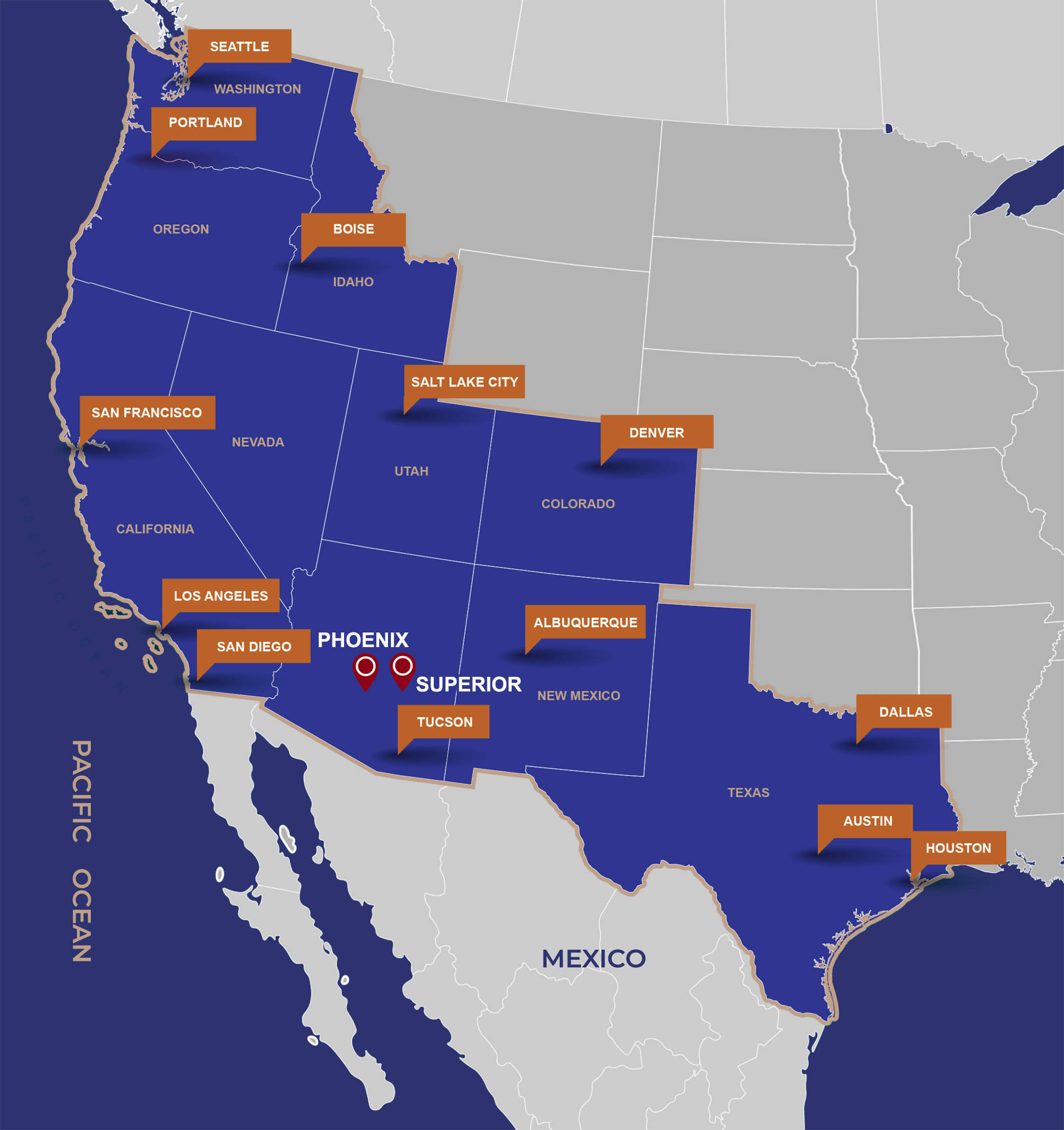PHOENIX METRO AREA
Superior is located 40 minutes east of the vibrant and rapidly expanding Phoenix Metro Area, the 10th largest metropolitan area in the U.S. ,with a highly diverse population and home to 5,215,050 people.
Source: U.S. Census Bureau, ESRI, September 2025.
Demographic Profile
Among the region’s residents, approximately 31.7% identify as Hispanic or Latino, 51% as White non-Hispanic, 6.2% as African American, 4.7% as Asian and 2.5% Native American. With a median age of 38.3, the Phoenix Metro Area is the 5th youngest metro out of all U.S. metros with populations of five million people or more.
Source: U.S. Census Bureau, ESRI, September 2025.
Market Access
Phoenix Sky Harbor International Airport is the region’s major aviation asset, directly connected to every continent across the globe. As the nation’s 11th busiest airport for passenger traffic, with 130,000+ daily passengers, companies can avail themselves of the 25 commercial airlines offering nonstop flights from Phoenix Sky Harbor to more than 130 domestic destinations and over 25 international destinations.
Source: Phoenix Sky Harbor, “By The Numbers,” Retrieved November 2025.
In addition, other regional airports such as Mesa Gateway Airport, just 45 minutes from Superior, offer business travelers flights to more than 45 cities and contributes $1.8 billion to Arizona’s economy annually. The airport had more than 978,000 passenger boardings in 2024. Many cities throughout the Phoenix Metro Area also have municipal airports that accommodate commercial and charter flights as well.
Sources: Mesa Gateway Airport, Retrieved November 2024; Federal Aviation Administration, Retrieved August 2025.
The region’s interstate and major state routes are modern, maintained and continue to be expanded to accommodate the interstate commerce activity from Arizona to points west, north and east. In addition to I-8, I-10 and I-17, the region benefits from a developed freeway system that connects major employment and residential areas through the metroplex.
Major state highways such as U.S. 60 serve as important routes to connect Arizona to other states. U.S. 60 is a major throughway connecting Superior to Phoenix and major commerce centers north, east and west as well.
Click on the map to view a larger image.
Economy
The Phoenix Metro Area boasts a dynamic and highly diversified economy, with key industries including technology, manufacturing, education, defense, healthcare, aerospace and aviation and finance. The region’s Gross Domestic Product (GDP) was more than $570.1 billion in 2024, showcasing strong economic growth.
Source: Federal Reserve Bank of St. Louis, Retrieved November 2025.
Major employers such as Intel, Virgin Galactic, Honeywell, Boeing, Carvana, ON Semiconductor, Charles Schwab, Stryker, Banner Health, Vanguard and American Express have established significant operations in the area. Emerging industries like renewable energy, bioscience and electric vehicle (EV) manufacturing are also gaining traction, contributing to the region’s economic dynamism diversification.
The tech industry experienced a 17.2% increase in employment between 2018 and 2023.
Source: CBRE Scoring Tech Talent Report 2024, September 2024.
Tech employment for 2026 is expected to increase by 1.0%.
Source: Arizona Office of Economic Opportunity, 2024-2026 Industry Employment Projections, Retrieved November 2025.
Factors contributing to this growth include the region’s competitive cost of living compared to other tech-centric areas, an influx of tech companies setting up operations and a strong focus on innovation and technological development.
Major tech employers in the region, such as Amazon, Meta, Alphabet, Microsoft, TSMC, GoDaddy, Avnet and scores of others, along with emerging industries in the biotechnology and renewable energy sectors, have played a significant role in driving this expansion.
This growth trajectory reflects the Phoenix Metro Area’s strategic investments in technology infrastructure, education and workforce development, positioning it as a key player in the national and world tech landscape.
Education and Training
The Phoenix Metro Area is home to a wide array of higher education institutions, from major public universities to community colleges and specialized private schools. The many educational opportunities available in the region provide students with a variety of programs and pathways for career and academic success.
Formal education and workforce development programs, supported by 40 training and postsecondary institutions located in the region, including Arizona State University, ensure that residents and workers have access to the skills needed for the jobs of today and the future.*
In addition, Central Arizona College with its five campus locations throughout Pinal County, and the 10 campuses of Maricopa Community Colleges, provide customized training for companies as well as AA and bachelor’s degree programs for a wide range of in-demand occupations.**
*Source: GPEC, Retrieved November 2025. **Source: Central Arizona College and Maricopa Community Colleges, Retrieved November 2025.
Top Region for Business
The following metrics illustrate the Phoenix Metro Area’s strong business environment.
Total Projects for
Mountain States Region
Source: Site Selection,
2025 Top Metros,
May 2025.
Highest-Rated Airports
in Customer Satisfaction
Source: J.D. Power,
2025 Airport Index Ranking,
September 17, 2025.
Industrial Markets
in the U.S.
Source: CommercialCafe,
2025 Industrial Report,
November 25, 2025.
Top Cities For
Real Estate Development
Source: CNBC,
Stable Housing Markets,
July 17, 2025.
Global Groundwork
Index Rankings
Source: Site Selection,
2025 Top States,
September 2025.
Busiest Airport
in the U.S.
Source: FAA
Total Enplanements,
September 15, 2025.
Visit the Arizona Advantages page to learn more about doing business in Arizona.







